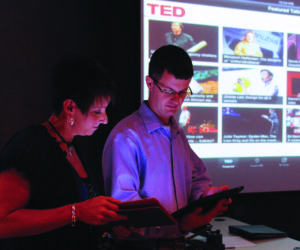In the age of ubiquitous and constantly evolving technologies, decisions about what to buy, when and how to deploy digital innovations work best when community colleges use systematic, team approaches.
The digital education leaders of Walters State Community College, Kirkwood Community College and Delta College offer insights about their colleges’ multi-faceted decision-making processes. They also share effective implementation practices.
Woven into governance
Kirkwood Community College in Cedar Rapids, Iowa, posts its IT strategic plan on its website with notations about the status of action items. The plan is updated every six months when Jon Neff, vice president of information technologies, reports to the college’s trustees and gains approval for the next six months.
“They give great input,” Neff says.
The content of the strategic plan is shaped by faculty representatives of every academic department who serve on the Learning Technology Advisory Committee, chaired by a tenured faculty member; a resource users group that is a subset of the cabinet led by the chief financial officer; and students.
The technology department uses surveys and roundtable discussions with students to identify their unmet needs, nuances with the technologies and problems. When it comes to gathering feedback from various campus constituencies, Neff says, “a single method is typically not adequate enough.”
Delta College, located in University Center, Michigan, serves more than 13,000 students. Technology considerations are linked through the institution’s strategic plan, IT strategic plan and its budget cabinet, which filters requests for technology and equipment.
Delta’s formal governance structure includes an IT council with 22 members who represent key areas of the college. The council develops tactical plans, shapes policies and reports information back its constituencies.
“They just really do a great job of making sure that we’re getting the input we need from all the areas of the college,” says Barbara R. Webb, Delta’s director of business services.
With a $100,000 threshold for expenditures that require board approval, Webb frequently interacts with the board regarding technology purchases.
Two-way street
Joe Sargent, assistant vice president of information and educational technologies at Walters State Community College in Morristown, Tennessee, describes IT decisions primarily as a “two-way street” between faculty and the IT department. Faculty make IT suggestions to deans who prioritize the purchase requests sent to the IT department. IT staffers also work directly with faculty who serve on pilot groups that test new software and hardware.
Editor’s note: This excerpt comes from the August/September 2017 edition of the Community College Journal, the flagship publication of the American Association of Community Colleges since 1930.
More than once, recommendations from pilot groups have prompted the IT department to change purchase plans and to research other options.

The Mobile Learning Fellows Program at Walters State Community College provides incentives to faculty who use technology to develop creative ways to increase student learning. (Photo: Walters State)
“Our faculty are pretty astute and technology minded,” Sargent says.
Years ago, there were times when the IT department was pulling the faculty along. Now, he says, it is often faculty members who are pushing the IT staffers to add a particular technology.
This yin-and-yang approach has helped the college keep its systems updated and avoiding problems. Recently, faculty requested a cloud-based technology for students to use to submit forms. It would have included financial aid documents. It had to be reworked when IT personnel discovered gaps in the product’s security for personal data. Similarly, the planned update of the college’s video conferencing system was placed on hold when none of the tested options performed better than the current equipment.

